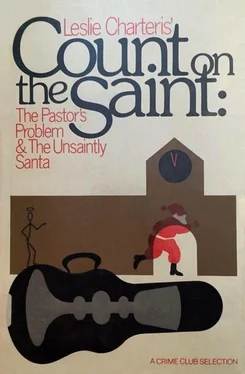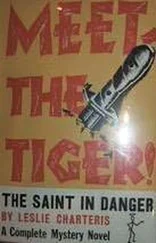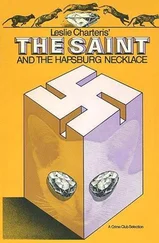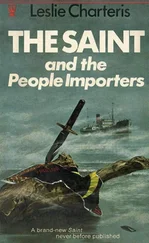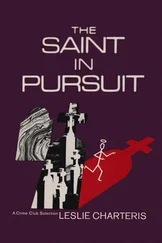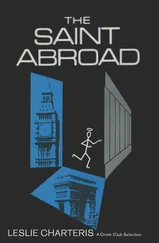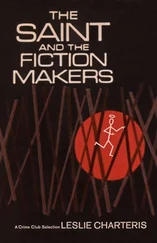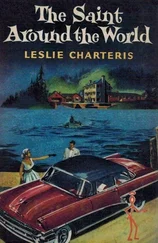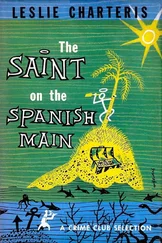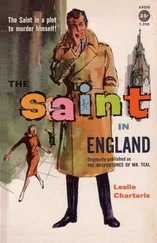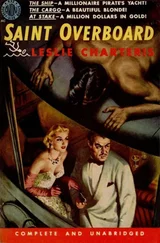Leslie Charteris
Count on the Saint
I
The Pastor’s Problem [1] Original outline by Donne Avenell Developed by Graham Weaver
The peace-loving, law-abiding residents of Upper Berkeley Mews had long ago become inured to the presence of their celebrated neighbour, though whether his decision to be domiciled amongst them was to be welcomed they had never quite decided. True, he added a certain glamour to that otherwise staid and soporific backwater, but on the other hand there was the ever present threat that he might one day bring his work home with him, so causing the tranquillity to be disturbed by undignified skylarking. Being British, and from that stratum of society which considers it bad form to discuss anything more private than the weather with anyone who has not been formally introduced, they compromised. They affected to ignore him, hoping he would reciprocate. At the same time they avidly read of his activities and kept a weather eye on his comings and goings to provide them with a ceaseless supply of gossip guaranteed to keep the conversation flowing over cocktails or coffee.
Their attitude was understandable. When the man next door is a criminal, a certain sense of insecurity is predictable; when he is the most notorious and successful outlaw of his age, it is inevitable.
For his part, Simon Templar was aware of their feelings and welcomed their reserve, for they saw only what he wanted them to see, and their reluctance to bother him in even the little of his private life that they did witness enabled him to go about his business unhampered by trivial interferences.
Any of his neighbours who saw him return home at ten o’clock one blustery September night in 1950 would have found nothing strange about either his actions or his appearance as he slotted his key into the lock.
They would have observed a tall athletic man with the permanently light tan of the seasoned traveller. If there was a certain piratical cast to the features and a subtly dangerous quality to the way he moved, these were only to be expected. They would have noticed that he was wearing a dark blue suit that hung with the millimetric precision that only the very best tailors achieve, with a silk shirt of such virginal whiteness that it might have been newly bought that morning. But being accustomed to seeing him so dressed, they would simply have concluded that he had enjoyed an early dinner, probably at one of the better hostelries, where he had doubtless selected the best food and the finest wines with the ease of the accomplished gourmet. And they would have been right.
Any of them still keeping an eye on his home ten minutes later would have seen the front door open and watched him emerge once again into the mews. They would have noted that he now wore a dark leather casual jacket, dark grey trousers, and a navy-blue rollneck sweater, and that the thin leather shoes had been replaced by a pair of workmanlike brogues. The rapid transformation might have caused an eyebrow to be raised and created a suspicion that he was up to no good. But he carried, of all inoffensive burdens, a plain black and somewhat shabby violin case. It suggested at once a minor musician on his way to work at some night club.
Simon Templar did not know whether he was under surveillance and he did not care. He walked briskly out of the mews and through the quiet Mayfair side streets until he reached Piccadilly, where he turned left. He considered hailing a taxi but decided against the idea. The traffic was crawling along even on that broad thoroughfare, and as his destination lay beyond a maze of narrow streets which at that time of night would be clotted with parked cars he realised it would be almost as quick to walk.
A few hundred yards later he arrived in Piccadilly Circus.
The Circus is the hub of London and the centre of what the guidebook writers are wont to call the “Bright Lights,” though any New Yorker would be surprised at the economy of syncopated neon employed to justify the description. To the tourist it is a sight to see, one more landmark ticked off the holiday itinerary. To the Londoner it is a symbol, even if he would find it hard to explain exactly what it symbolises. The attraction of the handful of major roads and minor side streets which tie themselves into a knot around the foot of the statue of Eros is not something that can be seen; it has to be felt.
Whenever there is an excuse for national celebration it is to Piccadilly Circus that the crowds flock, as if drawn by some giant invisible magnet. It is on the pavements of Piccadilly that the starry-eyed provincial in search of adventure and fame in the big city is most likely to first put down his — or more usually her — suitcase. Soldiers have sung their goodbyes to it, and Eros has become as national a symbol as the Eiffel Tower, the Statue of Liberty, or the onion domes of the Kremlin.
Perhaps part of its appeal is that it brings together four of the most famous districts of the capital: the shops of Regent Street with the theatres of Shaftesbury Avenue; Mayfair, which has become a byword for all that is English, elegant, and aristocratic; and Soho, which has become synonymous with the cosmopolitan, the tawdry, and the criminal.
Simon Templar turned to skirt the central island of the Circus and flicked up his jacket collar in token resistance to the drizzle that had just started to drain from an overcast sky. Anyone seeing him there might have thought it an appropriate place. Half an hour before, he had been relaxing in the sophisticated surroundings of a Mayfair restaurant. In another thirty minutes he would be equally at home attending to his business in the shabby streets of Soho.
It is part of the folklore of London that if you stand in Piccadilly Circus long enough you will eventually meet everyone you ever knew. At ten-forty that night the claim was almost believable. Cinemas and theatres disgorged their audiences onto the streets, and some were hurrying in search of supper while the early evening revellers were leaving the pubs and clubs in search of home. Swelling the jostling crowds were end-of-season tourists and that miscellaneous collection of unpigeonholeable characters who are to be found loitering at any time of the day, and most hours of the night, in every great meeting place in every great city of the world. The flotsam and jetsam of society, constantly changing faces that always look the same.
The public read about the Saint’s exploits and marvelled at his audacity. To them it must have appeared that he suddenly materialised in the right place at the right time as if by divine guidance. The usual fact, however, was that the events they digested with their bacon and eggs were the culmination of careful preparation, a major factor of which is attention to the minutiae of the task in hand. It was therefore no whim that had decided the time for his foray. For the next half hour the area would be at its busiest and he understood the value of the anonymity of crowds.
He dodged nimbly between the fenders of the cars inching into and out of Regent Street, crossed Glasshouse Street, and cut across the corner of the Regent Palace Hotel to turn up Sherwood Street. Within a dozen paces the lights and some of the exhaust fumes were left behind, and the shadows swallowed him. He turned right on Brewer Street; it was not the shortest way to his destination, but it was less congested, and he was able to maintain a brisker pace until he reached the junction with Wardour Street.
One of the delights of London is that the sprawling metropolis shown on the map is in reality just a collection of villages that the highways of the capital have threaded together without destroying their separate identities. Nowhere can this be more plainly seen than in the square mile lying between Oxford Street, Regent Street, Shaftesbury Avenue, and Charing Cross Road. In some ways Soho is not only a village within a city, it is almost a state within a country, and its boundaries are as tangible to those who live and work within them as the more conventional frontiers of mountains and rivers. Its people are drawn from every corner of Europe, many of them refugees from tyranny or poverty who have settled there and made it their own.
Читать дальше
